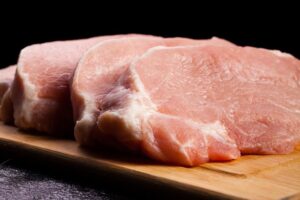Often overshadowed by loin, spareribs, and other pork meat options, salt pork and fatback hold a pivotal position in different recipes.

This article looks at the distinct difference between salt pork and fatback, highlighting their culinary applications and visual cues, among others. Let’s see how they stack up.
Salt Pork Vs Fatback: Curing
The most distinctive difference between salt pork and fatback is the curing process. Salt pork, as you’d guess, involves curing with salt. It is bathed in brine or sodium nitrate for weeks or months for preservation.
The process inhibits bacterial growth, draws out moisture, and retains the fat content. It is made from the pork side or pork belly and is a popular ingredient in many stews, soups, and other dishes.
Salt pork is a favorite for many since it adds a salty, savory flavor to dishes.
Fatback on the other hand is a cut of pork from the back of a pig. While it can be cured with salt, the salting is subtle and retains its fresh taste and flavor.
It is usually preserved through refrigeration and other conventional methods.
Salt pork is therefore cured for a longer period than fatback. This affects the flavor, making salt pork spicier than fatback.
The curing process also affects their cooking process. Salt pork is cooked until it gets a crisp texture. As mentioned, it makes dishes salty and savory.
Fatback, a fresher option, is cooked until it is rendered, adding flavor to your dishes.
So, salt pork is intended to be cooked and consumed as it is while fatback can be cooked further for additional flavor.
Salt Pork vs Fatback: Texture
Salt pork and fatback have varying textures due to their curing process.
Salt pork is firmer compared to fatback. Since the salt or brine absorbs water, it exhibits a well-defined leathery exterior that almost feels drier. Its chewiness is therefore bolstered, offering a more satisfying bite.
The textural profiles make salt pork ideal for different culinary applications. And since it is drier, it can be diced for a more robust flavor infusion.
So if you want to add pork flavor to slow-cooking dishes, make sure to dice your salt pork.
Fatback on the other hand has a soft and gelatinous texture, melting upon touch. And when consumed, it offers a distinct sensory experience while allowing you to enjoy its flavorful taste.
Salt Pork vs Fatback: Best Uses

The thick fat layer on salt pork makes it a viable option for classic dishes. It can used in dishes such as:
Baked beans where it is used to add a savory meaty flavor. It is a staple for traditional New England pork and beans dishes, also called Boston baked beans.
Salt pork provides an additional texture to the baked beans, making them sweeter.
You can also use it in soups and stews to add depth and richness. This is thanks to the high fat and salt content.
For example, you can use it with the New England clam chowder dish. The savory and sweet taste counterbalances the clam’s bitterness.
Asians use salt pork in their stir-fry dishes to elevate the flavor. The fat and salt content makes the dishes more savory. Salt pork is also a staple of collard greens.
Fatback is often used as an addition to other dishes. For example, it is often added to ground meat such as meatloaf, sausages, and meatballs. It elevates the moisture and fat content of the dish.
Ground meat with fatback is juicier and more flavorful than those without. That said, it may cause shrinkage if added in large portions.
It can also be used as a charcuterie ingredient. So if you are preparing mortadella or cured salami, experiment with fatback for a better taste and flavor.
When added to mortadella (a type of salami popular in Bologna, Italy), the white fatback stripes are distinguishable from the pale pink meat. Together, they offer you a sweet and flavorful taste.
Fatback can also be inserted in poultry or leaner meat for elevated juiciness and flavor. If you are using cuts of meat such as turkey breast, venison, or pork loin, the fat and flavor content will be minimal.
One way to boost the taste and consistency is to insert pieces of fatback. It will melt, significantly improving the taste and flavor of the fatless meat.
Salt Pork vs Fatback: Visual Clue
Salt pork has a brownish or grayish color due to the salting process. The color may however vary depending on the salt concentration and the curing duration.
Unlike fatback, salt pork is sold in pre-cut thick sticks, cubes, or slices. And thanks to its firm texture, it can hold its clean-cut appearance for an extended period.
Salt pork might also have a drier and wrinkled surface than fatback due to the salt drawing out the water content. You may also find a slight dusting of salt crystals. Overall, salt pork assumes a weathered and textured look.

Fatback has a white or pale pink color evoking a sense of freshness. Unlike salt pork which has a rigid shape, fatback pork comes in large chunks or slabs. It can also be sold ground.
The soft texture makes it seem malleable, common with meat with high-fat content. Fatback does not have a wrinkled surface. Rather, it has a smooth or almost glistening surface due to its high-fat content.
As you’d guess, it might appear translucent or moist in certain spots. Overall, fatback has a fleshy appearance.
Salt Pork Vs Fatback: Availability
Salt pork is pre-packaged and is readily available in most grocery stores. You can also find it in online stores since it has a longer shelf life.
Fatback pork is less common in grocery stores but you can find it in your local butchery. Most butcheries will need you to make an order as it is often sold fresh.
Salt Pork Vs Fatback: Storage
To extend the shelf life of your salt pork, you need to store it in the coldest section of your refrigerator. If you’ll be using it after a few months, freezing could be the best option.
If you buy it uncut, cut it into slices and wrap each slice in a plastic wrap.
You can store your fatback pork in plastic wrap in your refrigerator for 4 to 5 days. It can also be frozen for 6 to 12 months. However, make sure to store it in smaller chunks for easier defrosting.
Final Thoughts
Well, salt pork and fatback no doubt improve the flavor and taste of your dishes. Sourced from pig meat, they have a higher fat content than other red meat options. That said, fatback pork has more content than salt pork.
As you’ve seen, salt pork has more sodium content due to its curing process. Fatback is often sold fresh in most local butcheries. And since salt pork has a longer curing process, its shelf life is longer and you can get it in most grocery stores.
